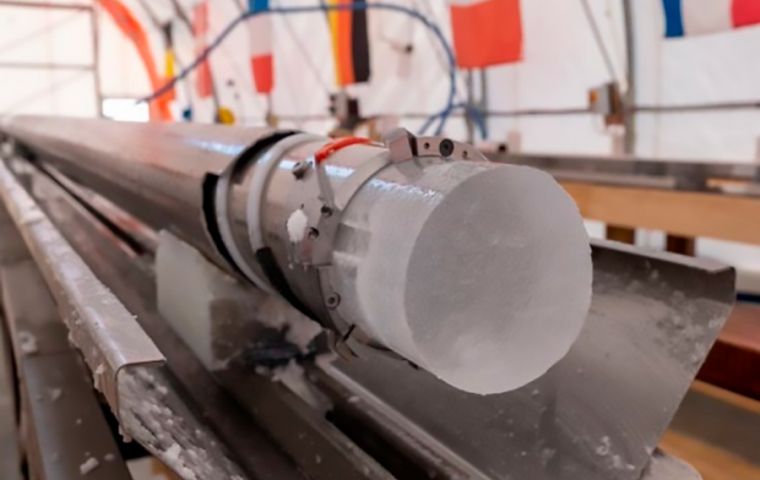MercoPress. South Atlantic News Agency
Drilling in Antarctica to find the Earth's oldest ice and 1,5 million years of climate history
 The 2022/23 drilling team at Little Dome C. Dr Rob Mulvaney, bottom left, is from BAS. Photo credit: Beyond Epica
The 2022/23 drilling team at Little Dome C. Dr Rob Mulvaney, bottom left, is from BAS. Photo credit: Beyond Epica Scientists in East Antarctica drilling to find the Earth’s oldest ice have reached a key milestone after two months of fieldwork in sub-zero temperatures. The team is part of Beyond EPICA – Oldest Ice, an EU-funded research consortium from 10 European countries whose aim is to drill an ice core to capture 1.5 million years of climate history.
The 15-person team drilled over 800 metres during their second phase of drilling, which will help them to reconstruct past temperatures and greenhouse concentrations and answer important questions about big shifts in the past record of Earth’s climate.
The drill site Little Dome C is an area of 10 km2, located 35 km from the Italian-French Concordia Station — one of the most extreme places on Earth. By analyzing the ice cores extracted from the deep ice in Antarctica, the project will collect information about the evolution of temperature, the composition of the atmosphere, and the carbon cycle.
Dr Robert Mulvaney from British Antarctic Survey (BAS) was there for drilling which started in December 2022 and concluded in late January. The team used a new drilling system provided by the Alfred Wegener Institut (AWI) in Germany. Despite severe weather conditions and a few problems with the drilling systems, the team worked on drilling shifts for 16 hours a day to reach the important milestone.
Robert Mulvaney, who’s a climate scientist and ice core drilling expert, says: “This is a significant achievement for the team using the AWI drill system. This is the longest core ever drilled by a European project. Its significance lies in the fact that at greater depths, where the time to winch down and up the borehole increases incrementally, being able to recover longer cores in each run means that we could progress faster with the drilling. It will cut the time needed to reach the bedrock, and the oldest ice.”
Dr Carlo Barbante, Project Coordinator of Beyond Epica – Oldest Ice and Director of the Institute of Polar Sciences of the Italian National Research Council (CNR-ISP) and Professor at Ca’ Foscari University of Venice, says: “This season has been intense but brought amazing results thanks to the team’s gigantic efforts. They worked tirelessly for two months at the Little Dome C camp. They first tested the equipment, and then progressed down to the remarkable depth of 808 meters and collected high quality ice cores. This will be our starting point for the next Beyond EPICA drilling season.”
This year, the first 217 meters from the Beyond Epica ice core were processed at the Cold Lab at nearby Concordia Station, making observations on the cores and measuring its conductivity parameters as well as performing the first cuts. A part of these ice cores will be transferred to Europe for analysis in European laboratories.

![“Working directly with President [Donald] Trump and Congress, we accomplished what no one else could,” Patel stressed](/data/cache/noticias/108417/130x80/fbi.jpg)


Top Comments
Disclaimer & comment rulesCommenting for this story is now closed.
If you have a Facebook account, become a fan and comment on our Facebook Page!